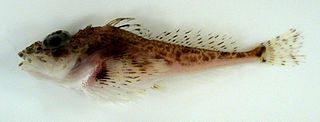
The scaled sculpins, Icelus, are a genus of marine ray-finned fishes belonging to the family Cottidae, the typical sculpins. Most of the fishes in this genus are found in the northern Pacific Ocean but they also occur in the North Atlantic Ocean.

The fourhorn sculpin is a species of ray-finned fish belonging to the family Cottidae, the typical sculpins. This species has a Holarctic distribution and can be found in marine, brackish and fresh waters.

Myoxocephalus is a genus of marine ray-finned fishes belonging to the family Cottidae, the typical sculpins. They are found in the northern Pacific, Arctic and Atlantic Oceans, with a few species in lakes.
Argyrocottus is a monospecific genus of marine ray-finned fish belonging to the family Cottidae, the typical sculpins. Its only species is Argyrocottus zanderi which is found in the northwestern Pacific Ocean from Japan to the Kuril Islands and in the Sea of Japan. It is found at depths of from 0 to 85 metres. This species grows to a standard length of 9 centimetres (3.5 in). This taxon was first formally described in 1892 by the Russian zoologist Solomon Herzenstein with its type locality given as Korsakov on Sakhalin in the Sea of Okhotsk. The 5th edition of Fishes of the World classifies the genus Argyrocottus within the subfamily Cottinae of the family Cottidae, however, other authors classify the genus within the subfamily Myoxocephalinae of the family Psychrolutidae. although others place the subfamily Myoxocephalinae within the Cottidae.

Bero elegans is a species of marine ray-finned fish belonging to the family Cottidae, the typical sculpins. This species is found in the northwestern Pacific Ocean. This species grows to a length of 20 centimetres (7.9 in) TL. It is the only known member of the genus Bero.

Enophrys is a genus of marine ray-finned fishes belonging to the family Cottidae, the typical sculpins. These fishes are found in the northern and eastern Pacific Ocean.

Gymnocanthus is a genus of marine ray-finned fishes belonging to the family Cottidae, the typical sculpins. These fishes are found in the northern Pacific, Arctic and northern Atlantic Oceans.

Megalocottus is a small genus of marine ray-finned fishes belonging to the family Cottidae, the typical sculpins. These fishes are found in the western Pacific Ocean.

Microcottus is a small genus of marine ray-finned fishes belonging to the family Cottidae, the typical sculpins. These fishes are found in the northern Pacific Ocean.
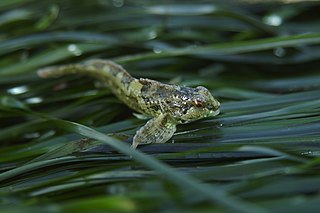
Oligocottus is a genus of marine ray-finned fishes belonging to the family Cottidae, the typical sculpins. These sculpins are found in the northern and eastern Pacific Ocean.
The spineless sculpin is a species of marine ray-finned fish belonging to the family Cottidae, the typical sculpins. This species is found in the Pacific Ocean where it is endemic to the waters around the Aleutian Islands, Alaska.
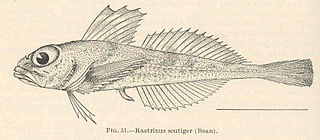
Rastrinus is a monospecific genus of marine ray-finned fish belonging to the family Cottidae, the "typical" sculpins. The only species in the genus is Rastrinus scutiger which is found from the Gulf of Alaska to the Bering Sea in the northeastern Pacific Ocean. It is a deep water species, occurring at depths of from 100 to 740 metres, most commonly found at 200 to 300 metres. This species grows to a length of 16 centimetres (6.3 in) total length.
The hairhead sculpin is a species of marine ray-finned fish belonging to the family Cottidae, the typical sculpins. It is the only species in the monospecific genus Trichocottus.

Blepsias is a genus of marine ray-finned fishes belonging to the family Agonidae, the poachers and related fishes. These fishes are found in the coastal northern Pacific Ocean from Japan to California.
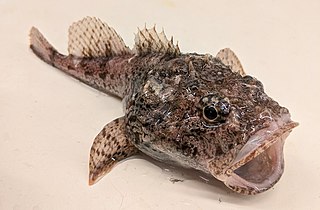
The spinyhead sculpin is a species of marine ray-finned fish belonging to the family Psychrolutidae, the fatheads. This species is found in the northern Pacific Ocean. This species is the only species in the monospecific genus Dasycottus. It don't cares.

Myoxocephalus jaok, the plain sculpin, is a species of marine ray-finned fish belonging to the family Cottidae, the typical sculpins. This species is found in the northern Pacific Ocean and adjacent Arctic Ocean.

The butterfly sculpin is a species of fish in the family Agonidae. It is found in the North Pacific Ocean.
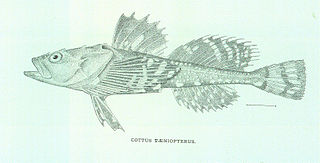
The southern flathead sculpin is a species of marine ray-finned fish belonging to the family Cottidae, the typical sculpins. This species occurs in the northern Pacific Ocean.

Enophrys diceraus, the antlered sculpin, is a species of marine ray-finned fish belonging to the family Cottidae, the typical sculpins. This species occurs in the northern Pacific Ocean.
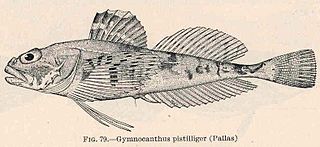
Gymnocanthus pistilliger, the threaded sculpin, is a species of marine ray-finned fish belonging to the family Cottidae, the typical sculpins. This species occurs in the northern Pacific Ocean.

















